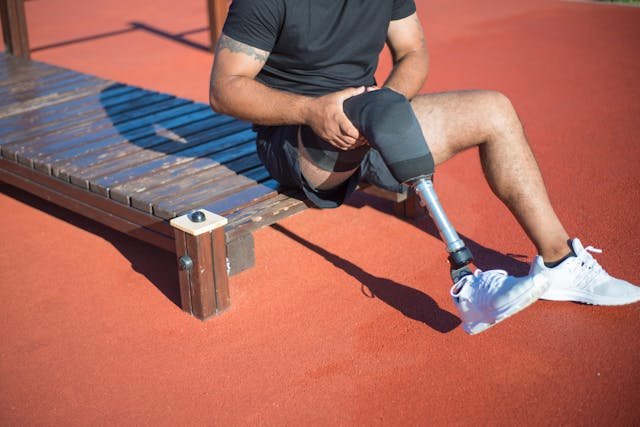Recovering from an amputation involves many changes—physical, emotional, and mental. One of the most important steps in this recovery is getting ready for your first prosthetic fitting. While this can be an exciting milestone, managing pain and swelling early in the process is key to making it a success. If not controlled properly, both pain and swelling can delay healing, make prosthetic fitting harder, and reduce comfort during movement.
At Robobionics, we understand how sensitive this stage is. We’ve worked with hundreds of individuals in India who face these same challenges. With the right tools and guidance, pain and swelling don’t have to hold you back. This guide will walk you through everything you need to know to manage your discomfort effectively, so you can move toward your prosthetic journey with confidence.
Understanding Pain After Amputation
Pain after surgery is normal. But not all pain feels the same, and understanding what kind you are feeling helps you manage it better. Knowing what’s expected and what needs attention makes your recovery safer and less stressful.
The Types of Pain You May Feel
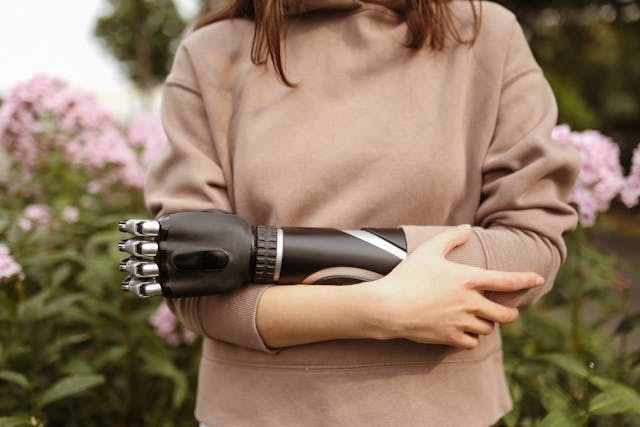
After an amputation, you may feel pain from the surgery itself. This is called residual limb pain. It comes from the area where the limb was removed. This pain is usually due to stitches, swelling, or the muscles healing. It tends to lessen as the wound heals, but it can still make it hard to move or rest comfortably.
You may also experience phantom limb pain. This happens when your brain still thinks the limb is there. The nerves that once carried messages to and from your limb can still send signals, even though the limb is gone. This can feel like burning, itching, or even sharp pain. It is confusing at first, but it is common and treatable.
At Robobionics, we take time to explain these sensations to each user. We help them know what’s normal and what needs extra care, so no one feels lost or unsure during recovery.
How to Respond to Early Pain
The best way to handle pain is not to ignore it but to manage it gently. This might include prescribed medicine, simple stretches, massage, or guided movement. Your doctor may also suggest desensitization techniques, like tapping or lightly touching the residual limb to reduce nerve sensitivity.
Pain can also be caused by tight bandages or incorrect compression techniques. That’s why it’s important to talk to your prosthetist or doctor if anything feels worse instead of better. They can check the limb and adjust care as needed.
At Robobionics, we offer education during every step of recovery. Whether it’s a question about medications or how to wrap your limb safely, our team is here to answer and support you.
The Emotional Side of Pain
Pain after amputation doesn’t just affect your body. It can also affect how you feel emotionally. When pain stops you from sleeping or moving, it can make you feel discouraged. Some people also feel anxiety or frustration when they don’t understand why the pain is happening.
Talking to someone about your pain—whether it’s a doctor, a prosthetist, or a loved one—can help reduce that emotional burden. Knowing that pain is a part of healing, not a sign of failure, gives you strength to keep going.
Robobionics provides emotional support as well as physical care. We believe healing happens best when both the body and mind are supported together.
Understanding Swelling and Why It Matters
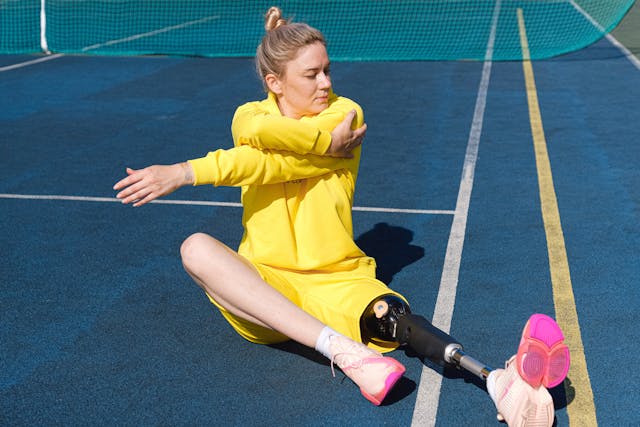
Swelling is one of the body’s natural ways of healing. After surgery, fluid collects in the tissues to protect the area. But too much swelling can slow down healing and make prosthetic fitting difficult. Managing this early on makes all the difference in your recovery timeline.
Why Swelling Happens
When your body goes through a big change like surgery, it responds by sending extra fluids to the area to protect it. This causes swelling, also known as edema. In the first few days, this is expected and even helpful. But if it stays too long or becomes too severe, it can cause pain and delay movement.
Swelling makes the limb feel heavy and sometimes hard to move. It can stretch the skin, make the area more sensitive, and lead to poor shaping of the residual limb. This is important because the shape of your limb affects how well your prosthetic socket will fit.
At Robobionics, we monitor swelling closely and help our users take simple steps to manage it every day, starting right after surgery.
How Swelling Affects Prosthetic Fitting
A prosthetic socket must fit snugly and evenly on your limb. If your limb is swollen or keeps changing shape, it becomes difficult to find the right socket fit. You may feel loose in the prosthetic or have pressure points that lead to pain. That’s why reducing swelling early is not just about comfort—it’s about getting your prosthetic journey off to the right start.
The earlier your limb reaches a stable shape, the sooner your prosthetic can be designed. A well-shaped limb leads to better alignment, fewer adjustments, and less discomfort when you start walking again.
Robobionics uses special tools to scan the limb and track changes over time. This helps us know exactly when you’re ready for your prosthetic fitting.
Controlling Swelling at Home
Managing swelling doesn’t require complicated equipment. In most cases, consistent compression, limb elevation, and gentle movement do the job well. Compression socks or bandages help push excess fluid out of the limb. Elevating your limb while sitting or lying down uses gravity to reduce pressure. And light movement, like wiggling your limb or lifting it gently, encourages circulation.
We teach every Robobionics user how to use these methods properly, with simple instructions and support. When done regularly, these habits become part of your daily care and help you feel better faster.
Using Compression Therapy to Manage Swelling and Pain
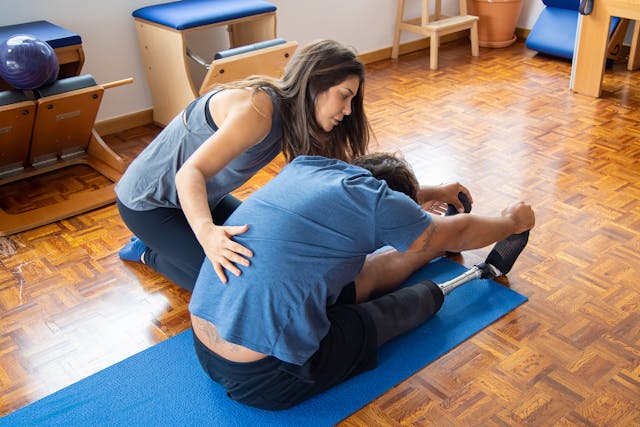
Compression therapy is one of the most effective ways to control swelling and reduce discomfort after an amputation. It’s simple, safe, and can be done at home with the right training. By applying gentle pressure to the residual limb, it helps your body heal faster and prepare for prosthetic use.
How Compression Reduces Swelling
When fluid builds up in the limb after surgery, it causes puffiness, discomfort, and delays the shaping process needed for a proper prosthetic fit. Compression works by squeezing the limb gently, which helps move this fluid out of the tissues and back into circulation. This reduces swelling and helps the limb take on a smoother, rounder shape.
This even pressure also supports skin health. It prevents the skin from stretching too much and keeps it firm, which is important when you begin wearing a socket that fits snugly over your limb.
At Robobionics, we guide users on when to start compression and how long to wear it each day. Our shrinkers and liners are made from soft, skin-friendly material designed to be used comfortably during early recovery.
Preparing the Limb for Prosthetic Weight-Bearing
The limb must eventually support body weight through a prosthetic socket. Compression therapy prepares the limb for this by gradually increasing the amount of pressure it can handle. This means when you finally begin walking or standing with your prosthesis, your limb is less likely to feel sore or sensitive.
The tissues inside the limb become firmer and more stable with regular compression. This reduces the risk of skin breakdown, rubbing, and blistering—all common issues for first-time prosthetic users if the limb isn’t ready.
Robobionics uses a step-by-step approach to introduce pressure safely. We check for any signs of discomfort and make changes to your compression routine as your limb changes shape.
Keeping Compression Comfortable and Safe
While compression is helpful, it’s important to do it correctly. Bandages that are wrapped too tightly can cut off circulation and cause pain. If they’re too loose, they won’t reduce swelling effectively. Learning the right technique makes a big difference.
That’s why at Robobionics, we teach every user how to wrap their limb correctly, how to use shrinker socks, and how to care for their skin underneath. We provide follow-up check-ins to ensure compression is working well and not causing any harm.
A well-managed compression routine helps speed up recovery and reduces many of the challenges that can slow down prosthetic fitting.
Limb Positioning and Movement: Simple Ways to Prevent Pain
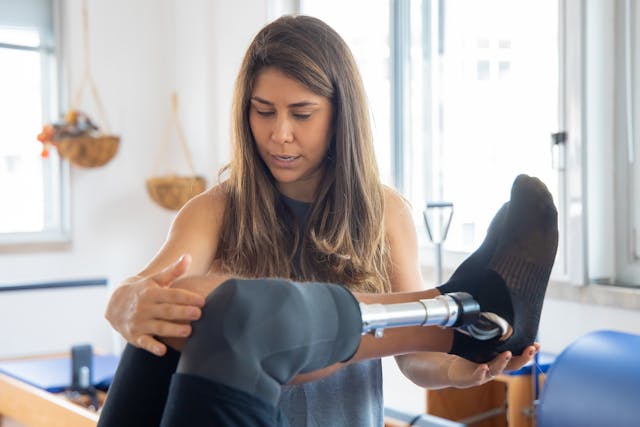
The way you position your limb after surgery can either help or hurt your recovery. When the limb is left in the same place for too long or held at odd angles, it can lead to stiffness, tight muscles, or even joint contractures. These issues make movement harder and can delay prosthetic training.
Avoiding Contractures Through Good Positioning
A contracture happens when a joint becomes stuck in one position for too long and loses its full range of motion. For example, if a below-knee amputee keeps their knee bent for long periods, the knee may become stiff and hard to straighten. This makes standing or walking with a prosthetic very difficult later on.
To prevent this, it’s important to keep the limb straight when resting. Lying flat with the knee extended or sitting with the foot on the floor helps maintain flexibility. Changing positions often throughout the day also keeps joints moving and avoids stiffness.
At Robobionics, we educate every user and their caregivers on the best postures for rest and sleep. We also share simple techniques that support long-term joint health.
Gentle Exercises to Improve Circulation and Comfort
Even small movements can make a big difference in pain and swelling. Gentle leg lifts, light stretching, or simple hip rotations encourage blood flow and reduce stiffness. These exercises also help re-engage the muscles that you’ll need once you begin walking again.
Many users are surprised by how much better they feel after just a few minutes of movement. It helps clear swelling, boosts mood, and improves sleep. Most importantly, it builds strength slowly, without putting stress on the healing limb.
Robobionics partners with physical therapists to create custom movement routines for each stage of recovery. We believe small daily efforts lead to bigger wins over time.
Supporting the Healing Limb During Daily Activities
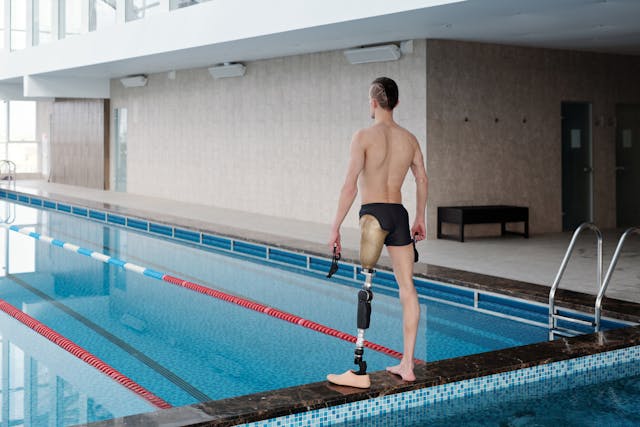
Pain can also come from bumping the limb or resting it on hard surfaces during normal activities. Using a soft pillow, foam support, or limb protector helps reduce pressure during sitting or resting. If you’re sitting for long periods, be sure to place the limb where it’s supported but not bent.
Even moving between rooms, getting out of bed, or shifting in a chair can cause discomfort if the limb is not protected. Developing good habits early keeps you safe and supports long-term comfort.
At Robobionics, we guide users on practical ways to manage comfort during everyday life. From how to position the limb on a car ride to tips for sleeping better, we cover every detail that helps ease pain naturally.
Preparing for Early Prosthetic Fitting Through Pain and Swelling Management
Managing pain and swelling is not just about feeling better—it’s about getting your body ready for the next step. The success of your early prosthetic fitting depends on how well your limb has healed, how stable the swelling is, and how strong your muscles feel. When these things are taken care of from the beginning, the transition into prosthetic use becomes much smoother.
Timing Your First Fitting for Best Results
Your prosthetist and doctor will decide when your body is ready for its first prosthetic fitting. This depends on a few key things—your wound should be closed and dry, your swelling should have reduced, and your limb should have a stable shape. If any of these are still changing too quickly, your prosthetic might not fit well or could cause discomfort.
Pain and swelling management is what helps get you to this stage faster. The better controlled they are, the sooner your team can begin the process. It also means fewer socket changes, fewer delays, and more comfort during walking.
At Robobionics, we schedule the first prosthetic evaluation only after ensuring the limb is healthy, strong, and ready. We don’t rush the process—we prepare you for success.
Improving Socket Fit Through Swelling Reduction
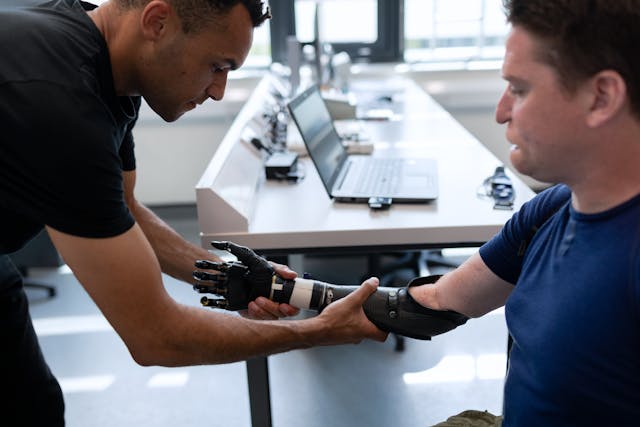
Swelling makes the residual limb larger, softer, and harder to fit inside a prosthetic socket. A limb that’s still changing in size leads to loose sockets, rubbing, and pain. But when the swelling is brought under control, your limb reaches a consistent size and shape. This makes it easier for your prosthetist to create a comfortable, well-fitting socket the first time.
A stable socket fit also reduces the need for constant adjustments. It helps you build better balance and trust in the prosthetic. With less shifting and discomfort, your energy can go into walking and therapy—not fixing the fit.
Robobionics uses 3D limb scanning and shape monitoring during this stage. This allows us to track your progress and start socket design at the exact right time.
Feeling More Confident During Early Steps
Perhaps the most important benefit of good pain and swelling management is how it helps you feel emotionally. When your limb is not throbbing, swollen, or overly sensitive, you’re more willing to try new movements. You’re less afraid to stand or take those first few supported steps.
That confidence makes a big difference. It helps you engage more in therapy, take part in your recovery, and believe in your ability to move forward. Early steps feel less like a challenge and more like a victory.
At Robobionics, we support this mindset by preparing your body with care and guiding your steps with patience. We believe confidence is built one moment at a time—and we’re here for every one of those moments.
Conclusion
Managing pain and swelling is not just about getting through the day—it’s about building a strong foundation for the future. When your limb is cared for, shaped, and supported from the start, your journey into prosthetic use becomes safer, smoother, and more successful.
Pain is not a sign of weakness, and swelling is not something to ignore. They’re both part of the healing process—but with the right tools, routines, and support, they don’t have to slow you down. Every compression sock worn, every careful movement made, and every moment of rest with proper positioning brings you one step closer to standing strong again.
At Robobionics, we understand how personal and powerful this journey is. That’s why we walk it with you—from your very first dressing to your first step in a prosthetic. We combine expert care, easy-to-follow routines, and ongoing support to make sure your recovery isn’t just possible—it’s empowering.
If you’re getting ready for prosthetic use and want help managing pain and swelling the right way, reach out to Robobionics today.



